Arnequinol A and arnequinone A, two unique meroterpenoids from Arnebia euchroma
Hai-Wei Yan, Rong-Rong Du, Xu Zhang, Ya-Nan Yang, Xiang Yuan, Zi-Ming Feng,Jian-Shuang Jiang, Pei-Cheng Zhang
State Key Laboratory of Bioactive Substance and Function of Natural Medicines, Institute of Materia Medica, Chinese Academy of Medical Sciences and Peking Union Medical College, Beijing 100050, China
Keywords:Arnebia euchroma Meroterpenoids Arnequinol A and arnequinone A Cytotoxicity Neuroprotective activity
ABSTRACT Arnequinol A (1), featuring an unprecedented 6/6/3 tricyclic carbon skeleton fused with a heptatomic oxo-bridge, together with arnequinone A (2) bearing a highly conjugated methyl-shifting benzogeijerene skeleton, were isolated from Arnebia euchroma.Their structures were elucidated by extensive spectroscopic methods and quantum chemical calculations of the 13C nuclear magnetic resonance (NMR) data and electronic circular dichroism (ECD) spectra.The plausible biosynthetic pathways for 1 and 2 were presented.In in vitro test, compound 2 showed potent neuroprotective activity against serum-deprivation induced PC12 cell damage at a concentration of 10 μmol/L.
The Boraginaceae family, composed of about 130 genera, encompasses about 2700 species, which are distributed in tropical,sub-tropical, and warmer regions world-wide [1,2].Extensive phytochemical investigations have revealed that some genera of this family, especiallyCordia[3–5],Arnebia[6–8] andAuxemma[9,10],presented an abundant source of structurally diverse and biologically active meroterpenoids, consisting of a quinone or hydroquinone linked to a monoterpene motif.The linkage patterns and positions of these two units, and the intramolecular cyclization and rearrangement reactions of the monoterpene moiety provide great potential to the structural diversity of meroterpenoids from this family [4,9,11–13].To our knowledge, the benzogeijerene skeleton formed by the Cope rearrangement of monoterpene moiety was exclusively found in the Boraginaceae plants [3,14,15].
Arnebia euchroma(Royle) Johnst.belonging to the family Boraginaceae, is a commonly prescribed traditional herbal medicine to treat skin eruption and ulcers, smallpox, jaundice, burn wounds,eczema, and constipation [16].Up to now, there have been about 40 meroterpenoids reported fromA.euchroma, of which some compounds displayed potent antiviral, anti-microbial, and cytotoxic activities [13,17–20].During our further endeavor to discover novel and bioactive meroterpenoids, arnequinol A (1) and arnequinone A (2) were isolated from the roots ofA.euchroma.Compound 1 possesses a new 6/6/3 tricyclic carbon skeleton fused with a heptatomic oxo-bridge.And compound 2 bears a novel highly conjugated aromatic system after the 1,2-migration of its tertiary methyl and elimination reaction (Fig.1).This study describes the isolation,structure elucidation, and proposed biosynthetic pathways of 1 and 2.Thein vitrocytotoxic activity of 1, 1a (the oxidation product of the aglycone of 1) and 2, as well as neuroprotective activity of 1 and 2 were also evaluated.
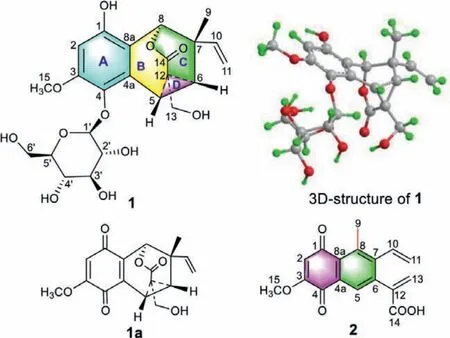
Fig.1.Chemical structures of 1, 1a and 2.
Arnequinol A (1) was obtained as a white amorphous powder.Its molecule formula C23H28O11with ten indices of hydrogen deficiency was deduced from the high resolution electrospray ionization mass spectroscopy (HRESIMS) sodium adduct ion peak atm/z503.1521 (calcd.for C23H28O11Na, 503.1524).The infrared(IR) absorptions suggested the existence of hydroxyl (3378 cm-1),carbonyl (1698 cm-1), and phenyl (1604, 1505 and 1459 cm-1)functionalities.The1H nuclear magnetic resonance (NMR) data(Table 1) showed signals for a pentasubstituted benzene ring proton (δH6.61, s), a monosubstituted vinyl [δH6.12 (dd,J= 17.5, 11.0 Hz), 5.42 (d,J= 17.5 Hz), and 5.31 (d,J= 11.0 Hz)], an oxymethine proton (δH5.46, s), an anomeric proton [δH4.82 (d,J= 7.5 Hz)],a hydroxymethyl [δH3.94 (d,J= 12.0 Hz) and 3.89 (d,J= 12.0 Hz)], a methoxy (δH3.86, s), two mutual coupling sp3methine protons [δH3.57 (d,J= 7.5 Hz) and 2.44 (d,J= 7.5 Hz)], and a tertiary methyl group (δH0.88, s).Additionally, four oxymethine resonances (δH3.31-3.62, m) and an oxymethylene group (δH3.77,br s) attributable to a glucosyl moiety were observed.The13C NMR associated with the heteronuclear single quantum coherence(HSQC) spectra assigned 23 carbon signals to an ester carbonyl(δC176.5), a monosubstituted double bond (δC144.3 and 118.1),a phenyl group (δC156.0, 153.7, 139.4, 131.7, 113.2 and 102.2), a glucosyl unit (δC106.9, 78.8, 78.7, 76.5, 72.0 and 63.2), three sp3methines involving one oxygenated (δC78.6, 32.2 and 28.6), a hydroxymethyl (δC66.7), a methoxy (δC58.8), a methyl (δC23.8) and two sp3nonprotonated carbons (δC41.0 and 37.8).Since a carbonyl,a phenyl, a double bond, and a glucosyl accounted for seven of the ten indices of hydrogen deficiency, the remaining ones required another three rings for 1.

Table 1 1H (500 MHz) and 13C (125 MHz) NMR data for compounds 1, 1a, and 2 (δ in ppm, J in Hz).
Interpretation of the1H-1H COSY spectrum (Fig.2) indicated two key spin systems, H-5/H-6 and H-10/H2-11.The heteronuclear multiple bond correlation (HMBC) (Fig.2) correlations from H-2 to C-1, C-3, C-4 and C-8a evidenced the presence of a pentasubstituted benzene ring.The HMBC correlations from H-5 to C-4, C-4a and C-8a, and from H-8 to C-1, C-4a and C-8a established the linkages of C-5 to C-4a and C-8 to C-8a.Meanwhile, MeO-15 and the glucosyl were positioned at C-3 and C-4, respectively, in the light of the HMBC correlations from MeO-15 and H-1′ to the corresponding carbons.Further HMBCs of H-8 with C-6, H-6 with C-8,H-5 with C-7, CH3-9 with C-6, C-7, C-8 and C-10, and H2-11 with C-7 constructed a six-membered carbon ring fused with the benzene ring at C-4a/C-8a and located the monosubstituted double bond and Me-9 at C-7.Moreover, a cyclopropane ring fused to the six-membered carbon ring at C-5 and C-6 was evidenced from the HMBCs of H2-13/C-5, C-6, and C-12, H-5/C-12 and C-13, and H-6/C-5 and C-13.The last degree of unsaturation was furnished with an ester bridge between C-8 and C-12 based on the HMBC correlations from H-5, H-6, H-8, and H2-13 to C-14.Therefore, the planar structure of 1 was unequivocally established (Fig.1), featuring a unique 6/7/6/3 tetracyclic system.
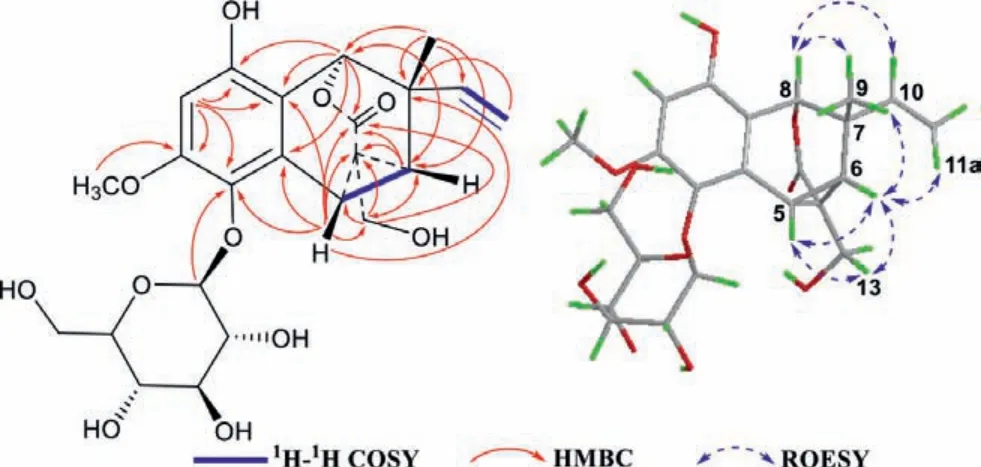
Fig.2.Key 1H–1H COSY, HMBC and ROESY correlations of 1.
Theβ-anomeric configuration of the glucosyl moiety was defined by the coupling constant [δH4.82 (d,J= 7.5 Hz)] of the anomeric proton, and then the D-glucose was ascertained by gas chromatography (GC) analysis [21] (Fig.S2 in Supporting information) after the snailase hydrolysis of 1.Interestingly, during the hydrolysis process, the aglycone of 1 was autoxidized [22] to its quinone form 1a (for NMR data, see Table 1).The relative configuration of 1a was deducedviathe rotating frame overhauser spectroscopy (ROESY) experiment, conformation analysis, and13C NMR calculation.The ROESY correlations (Fig.2) of H-5/H2-13, H-6/H2-13, and H-5/H-6 revealed that H-5, H-6, and CH2-13 were positioned at the same face of the cyclopropane ring.Given the rigidity of the cyclopropane ring and the ester bridge, H-5, H-6,and H-8 must be all in the equatorial orientation (Fig.2 and Fig.S1 in Supporting information), resulting that the relative configuration at C-7 cannot be resolved though the ROESY correlations of both H-6 and H-8 with Me-9 exist.Hence there are two possible relative configurations for 1a [(5S*,6R*,7R*,8R*,12S*)-1a and(5S*,6R*,7S*,8R*,12S*)-1a, Fig.3].The theoretical calculations of13C NMR chemical shifts of the above two possible isomers were conducted using the GIAO method (Supporting information), following a reported STS protocol [23], which corrected systematic errors according to the types of carbon.As shown in Fig.3 and Fig.S4 (Supporting information), compared with the experimental data of 1a, (5S*,6R*,7R*,8R*,12S*)-1a exhibited smaller mean absolute error (MAE) and root mean square (RMS) values with aPrelprobability of 99.97%, defining the relative configuration of 1a as 5S*,6R*,7R*,8R*,12S*with no doubt.Finally, a pair of eligible enantiomers (5S,6R,7R,8R,12S)-1a and (5R,6S,7S,8S,12R)-1a were employed for electronic circular dichroism (ECD) calculations using the time-dependent density functional theory (TDDFT) method at the CAM-B3LYP/6-31+g (d, p) level (Supporting information).The calculated ECD spectrum (Fig.4) of (5S,6R,7R,8R,12S)-1a matched well with the experimental ECD curve of 1a allowing the absolute configuration of 1a determined.
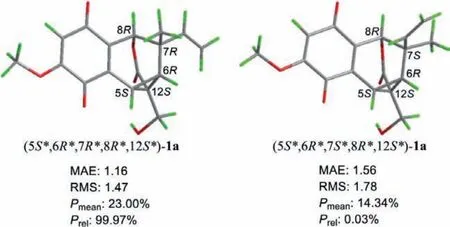
Fig.3.The 13C NMR chemical shifts calculation results of a pair of C-7 epimers of(5S*,6R*,7R*,8R*,12S*)-1a and (5S*,6R*,7S*,8R*,12S*)-1a.
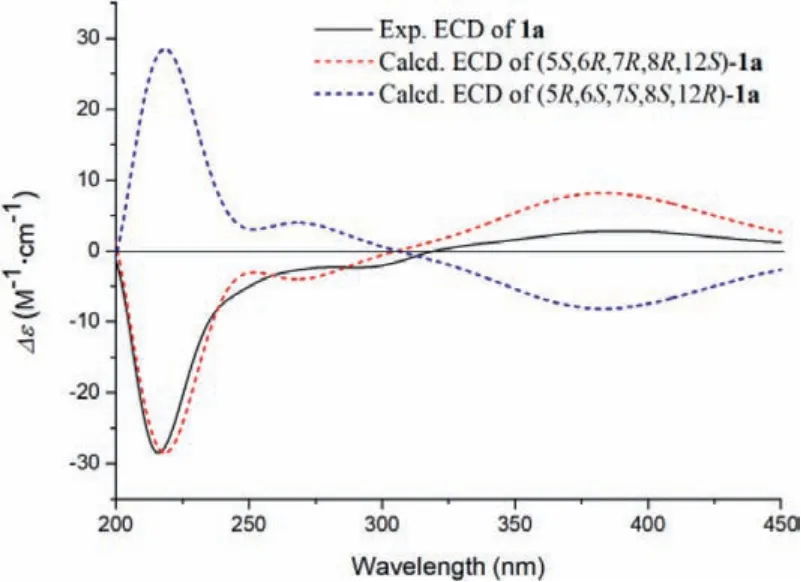
Fig.4.Experimental ECD and calculated ECD spectra of 1a.
Arnequinone A (2), yellowish amorphous powder, had a molecular formula C17H14O5as determined by the HRESIMS peak atm/z299.0914 [M + H]+(calcd.for C17H15O5, 299.0914), indicative of eleven degrees of unsaturation.The IR spectrum revealed absorption bands for carbonyl (1682, 1645 cm-1) and phenyl (1615, 1581,1445 cm-1) groups.The1H NMR data (Table 1) displayed signals for an active carboxy hydrogen (δH13.07, br s), a monosubstituted vinyl [δH7.08 (dd,J= 18.0, 11.5 Hz), 5.51 (dd,J= 11.5, 1.5 Hz),and 5.07 (dd,J= 18.0, 1.5 Hz)], a pair of geminal olefinic protons[δH6.51 (d,J= 1.0 Hz) and 5.90 (d,J= 1.0 Hz)], two single aromatic protons [δH7.70 (s) and 6.25 (s)], a methoxy (δH3.83, s),and a methyl (δH2.22, s).The13C NMR data indicated three carbonyls, twelve sp2carbons, a methoxy, and a methyl.All these aromatic carbons represented nine out of eleven degrees of unsaturation, disclosing a dicyclic nucleus for 2.The key HMBC correlations(Fig.5) from H-2 to C-1, C-3, C-4 and C-8a, from H-5 to C-4, C-7 and C-8a, and from Me-9 to C-7, C-8 and C-8a constructed the dicyclic nucleus as a 1,4-naphthoquinone with the methyl situated at C-8.Furthermore, HMBCs between H-10 and C-8, between H2-11 and C-7, between H2-13 and C-6/C-12/C-14, between H-5 and C-12, and between MeO-15 and C-3 established the linkages of C-7/C-10, and C-6/C-12, and locations of the carboxy and methoxy substituents at C-12 and C-3, respectively.All the above clarified the structure of 2 as a highly conjugated aromatic meroterpenoid with a methyl-shifting benzogeijerene skeleton (Fig.1) [3,14,15].
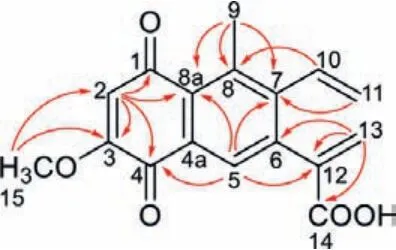
Fig.5.Key HMBC correlations of 2.
Biosynthetically, the key intermediate b (Scheme 1) with a benzogeijerene skeleton was yieldedviaa Cope rearrangement of a[3,15,24].Subsequent oxidation and esterification cyclization could generate d.Furthermore, intermediate d underwent a nucleophilic reaction to produce e with the 6/7/6/3 ring system, which would be readily transformed to 1 through selective oxidation methylation and glycosylation.Additionally, the dehydration of intermediate c, followed by the subsequent methyl 1,2-shift and elimination reaction generated intermediate g, which proceeded oxidation methylation at C-3, cooperated with an autoxidation process to yield compound 2.Notably, the autoxidation of methoxylated g and the aglycone of 1 might be a common feature for 2-methoxyhydroquinones [22].
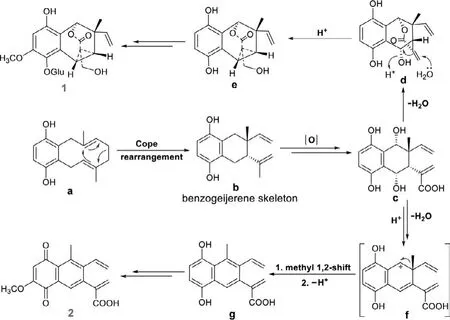
Scheme 1.Proposed biosynthetic pathways of 1 and 2.
The cytotoxic activities of 1, 1a and 2 against five human tumor cell lines (HCT116, U87-MG, BGC803, HepG2 and PC9) were evaluated using the MTT assay as described in the literature [25].1a exhibited cytotoxicity against all the tested cell lines except HepG2 with the half maximal inhibitory concentration (IC50) values ranging from 19.9 μmol/L to 25.9 μmol/L (Table S3 in Supporting information ).Compounds 1 and 2 showed no cytotoxicity (IC50>50 μmol/L, Table S3).Then 1 and 2 were tested for their neuroprotective activities against serum-deprivation induced PC12 cell damage using nerve growth factor (NGF) as the positive control [26].Compound 2 showed neuroprotective activity with a cell survival rate of 66.50% ± 1.53% compared to that of the model group (51.93%± 1.36%) at a concentration of 10 μmol/L (Supporting information Table S4).
In conclusion, arnequinol A (1) represents an unprecedented 6/6/3 tricyclic carbon skeleton fused with a heptatomic oxo-bridge.Arnequinone A (2) bearing a novel highly conjugated aromatic system, was the first example with a methyl-shifting benzogeijerene skeleton in the meroterpenoids from Boraginaceae plants.Their structural novelty could enrich the chemical diversity of meroterpenoids and the chemical constituents ofA.euchroma.
Declaration of competing interest
The authors declare that they have no known competing financial interests or personal relationships that could have appeared to influence the work reported in this paper.
Acknowledgment
This work was supported by the CAMS Innovation Fund for Medical Sciences (No.2016-I2M-1-010, China).
Supplementary materials
Supplementary material associated with this article can be found, in the online version, at doi:10.1016/j.cclet.2021.09.064.
 Chinese Chemical Letters2022年5期
Chinese Chemical Letters2022年5期
- Chinese Chemical Letters的其它文章
- Recent advances in enhancing reactive oxygen species based chemodynamic therapy
- An integrative review on the applications of 3D printing in the field of in vitro diagnostics
- Recent developments of droplets-based microfluidics for bacterial analysis
- Dynamics and biological relevance of epigenetic N6-methyladenine DNA modification in eukaryotic cells
- Recent progress in advanced core-shell metal-based catalysts for electrochemical carbon dioxide reduction
- Recent advances in carbon-based materials for electrochemical CO2 reduction reaction
